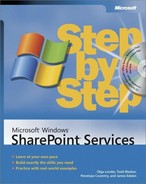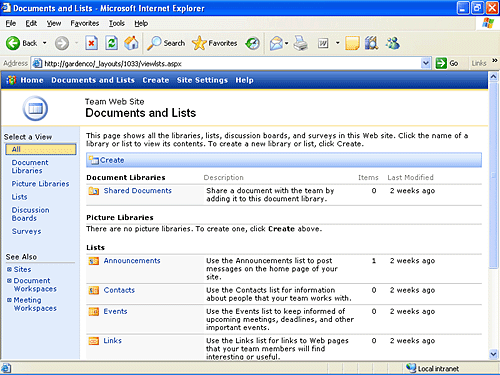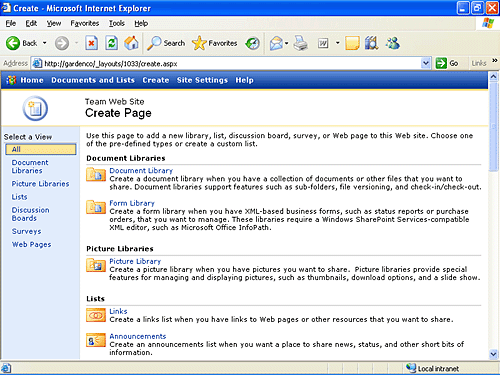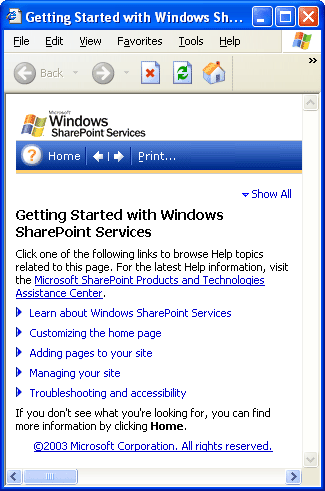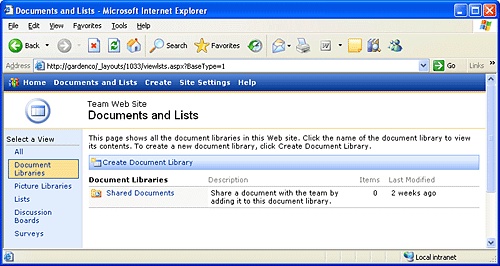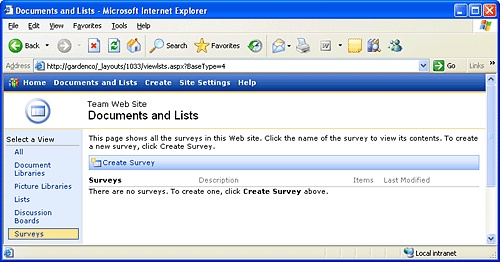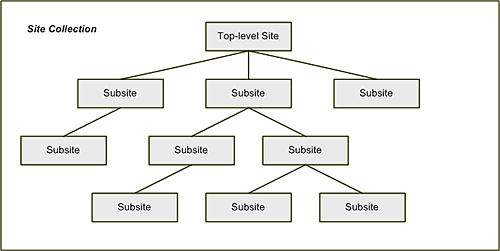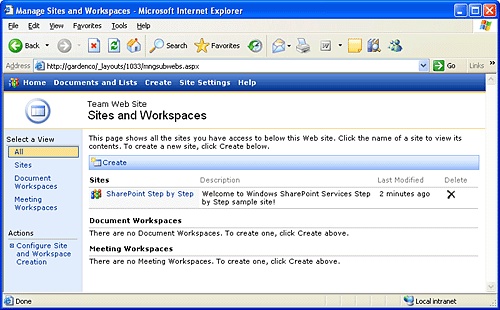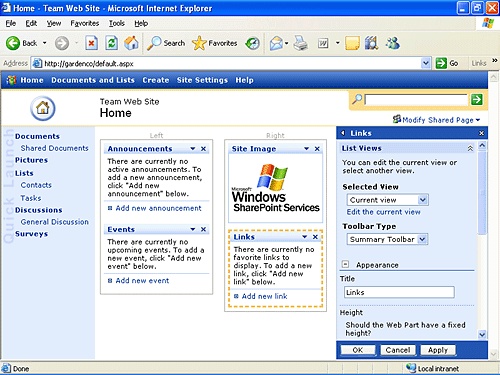In this chapter you will learn to:
Navigate the Home Page and the SharePoint site.
Navigate the site hierarchy.
Browse the lists on a SharePoint site.
Browse the document libraries.
Understand Web Part Pages.
A typical Microsoft Windows SharePoint Services Web site provides you with an infrastructure where your team can communicate, share documents and data, and work together. Different types of SharePoint sites have different infrastructures, such as a team site, a blank site, a Document Workspace and a Meeting Workspace. The team site infrastructure includes the following components:
Libraries. Document, picture, and form libraries are collections of files that you share and work on with your team members. A typical team site includes a built-in document library called Shared Documents. You can create your own document, picture and form libraries when needed.
Lists. With SharePoint lists, you and your team members can work with structured, tabular data on the Web site. A typical team site includes five built-in lists: Announcements, Contacts, Events, Links, and Tasks. There are other lists provided by Windows SharePoint Services that you can add to your site if required. You can also create custom lists.
Discussion boards. Discussion boards provide a forum where you and your team members can post comments and reply to each others' comments. By default, a typical team site comes with a built-in discussion board named General Discussion. You can create your own discussion boards when needed.
Surveys. Surveys provide a way of polling team members. SharePoint sites don't have a built-in survey, but you can create your own.
In this chapter, you will learn how to navigate the SharePoint site infrastructure. You will start with the home page of a typical SharePoint site, then learn how to browse the site hierarchy. You will also learn how to navigate the lists and libraries on your SharePoint site, as well as understand the concept of Web Part Pages.
See Also
Do you need only a quick refresher on the topics in this chapter? See the Quick Reference entries in Quick Reference.
Important
Remember to use your SharePoint site location in place of http://gardenco in the exercises.
A home page is the main page of a SharePoint Web site; it provides a navigational structure that links the site components together. Typically, a home page of a SharePoint site has two main navigation areas: the top link bar at the top of the page and the Quick Launch bar at the left of the page.
The top link bar is displayed on all pages within the SharePoint site and provides the following links:
Home. The Home link opens the home page for a site.
Documents and Lists. The Documents and Lists link opens the Document and Lists page, which lists all the libraries, lists, discussion boards, and surveys on your site. The Document and Lists page also provides links to the child sites and workspaces; it is your main navigational aid for the site.
Create. The Create link opens the Create Page page, which enables you to add a new library, list, discussion board, survey, or Web page to your site.
Site Settings. The Site Settings link opens the Site Settings page, which enables you to administer and customize your site.
Help. The Help link opens Windows SharePoint Services Help, which is launched in a separate window. The content displayed in this window is contextspecific and depends on the page you are viewing.
Depending on the site, the Quick Launch bar has one or more links to the subsets of information contained in the Documents and Lists page. These subsets, referred to as views, are created by filtering the information contained within this page. The Quick Launch bar can also contain links to site components created by you and your team members, for example, document libraries or lists. Usually, the Quick Launch bar contains the following links:
Documents. The Documents link opens a view of a Document and Lists page, which shows all the document and form libraries in your site.
On a typical team site, the Quick Launch bar also provides a second level link to a Shared Documents library.
Pictures. The Pictures link opens a view of a Document and Lists page that shows all picture libraries in your site.
Lists. The Lists link opens a view of a Document and Lists page that shows all lists in your site. On a typical team site, the Quick Launch bar also provides two second level links to Contacts and Tasks lists.
Discussions. The Discussions link opens a view of a Document and Lists page that shows all discussion boards in your site. On a typical team site, the Quick Launch bar also provides a second level link to a General Discussion board.
Surveys. The Surveys link opens a view of a Document and Lists page that shows all surveys in your site.
In addition to the top link bar and the Quick Launch bar, a home page of a typical SharePoint team site includes views of the following lists:
Announcements
Events
Links
Each of these lists is presented within its own page component called a Web Part. You can add items to these lists by clicking Add item within the list's Web Part.
In this exercise, you will navigate to the Surveys page, and then go back to the home page.
OPEN your SharePoint site, for example, http://gardenco. If prompted, type your user name and password, and then click OK.
On the Quick Launch bar, click Surveys.
The Document and Lists page opens in the Surveys view.
Explore the page.
Notice that the top link bar hasn't changed. However, there is no Quick Launch bar. Instead, there is a menu of actions specific to the functionality of the page: in this case, the menu enables you to view other components of your SharePoint site.
The main part of the page lists the surveys on the site. The Garden Company site hasn't created a survey yet, so this page doesn't display any surveys.
 Click Home on the top link bar to go back to the site's home page.
Click Home on the top link bar to go back to the site's home page.
CLOSE Internet Explorer.
See Also
For more information on working with surveys, refer to Chapter 9.
A SharePoint site can have many subsites, the hierarchy of which, on Web servers, resembles the hierarchy of folders on file systems. Sites that do not have a parent site are referred to as top-level sites. Top-level sites can have multiple subsites, and these subsites can have multiple subsites, down as many levels as you need. The entire hierarchical structure of a top-level site and all of its subsites is called a site collection.
If you have Administrator rights on the parent site, you can view the list of all subsites to the parent site. This list displays only the immediate subsites for the current site (one level down).
In this exercise, you will view a list of subsites to your SharePoint site. You will browse to this list in two different ways. You will also navigate the sites' hierarchy.
OPEN the SharePoint site to which you'd like to view the subsites. If prompted, type your user name and password, and then click OK.
BE SURE TO verify that you have sufficient rights to view the subsites. (For this exercise, Administrator rights are required.) If in doubt, see the Appendix .
On the top link bar, click Site Settings.
On the Site Settings page, under Administration, click Manage sites and workspaces.
On the Sites and Workspaces page, under Sites, explore the list of the subsites to your site.
On the top link bar, click Home.
You will now browse to the list of subsites in different way.
On the top link bar, click Documents and Lists.
On the Documents and Lists page, on the left pane under See Also, click Sites.
You might need to scroll down to see this link.
On the Sites and Workspaces page under Sites, click a subsite.
Each subsite within the site hierarchy, apart from the top-level site, has the link to the parent site displayed on the top link bar.
On the subsite's home page, on the right side of the top link bar, click the link that points up to the parent site, such as Up to Team Web Site.
You are taken back to the home page of the parent site.
CLOSE Internet Explorer.
See Also
For more information on working with sites, refer to Chapter 3.
SharePoint lists are Web-based, editable tables. SharePoint lists provide you and your team with the ability to work with structured data. As we have discussed, the typical team Web site provides five default lists, all of which appear by default on the team site home page:
Announcements. The Announcements list is a place to post information for the team.
Contacts. The Contacts list stores information such as name, telephone number, e-mail address, and street address for people who work with your team.
Events. The Events list is a place to post important dates.
Links. The Links list displays hyperlinks to Web pages of interest to team members.
Tasks. The Tasks list provides a to-do list for team members.
In addition to these default lists, you can create your own lists when required. When creating a new list, you might choose to place a link to this list on the Quick Launch bar.
See Also
For more information on working with lists, refer to Chapter 4.
In this exercise, you will view a list of all SharePoint lists that exist on your site. You will then navigate to a list, and then back to the home page.
OPEN the SharePoint site in which you'd like to view the existing lists. If prompted, type your user name and password, and then click OK.
On the top link bar, click Documents and Lists.
On the Documents and Lists page under Lists, links to all existing lists in your site are displayed.
Click a list, for example, Announcements.
On the list page, view the list items. For example, the Announcements list on The Garden Company site has only one default item.
To go back to the site's home page, click Home.
CLOSE Internet Explorer.
SharePoint libraries not only store files, but provide a flexible collaboration environment for you and your team to work on files.
A SharePoint library page lists each file in this library as well as its properties, and provides a link to each file. By default, the team site comes with a built-in document library named Shared Documents that is listed on the Quick Launch bar.
In addition to the Shared Documents library, you can create your own document, picture, and form libraries when required. When creating a new library, you might choose to place a link to this library on the Quick Launch bar.
See Also
For more information on working with documents in the document libraries, refer to Chapter 5. For more information on configuring the document libraries, refer to Chapter 6.
In this exercise, you will view a list of all SharePoint libraries that exist on your site. You will then navigate to a Shared Documents library.
OPEN the SharePoint site in which you'd like to view the list of existing libraries. If prompted, type your user name and password, and then click OK.
On the top link bar, click Documents and Lists.
On the Documents and Lists page under Document Libraries, links to all existing document and form libraries are displayed.
Click a link, for example, Shared Documents.
The Shared Documents page appears.
On the Shared Documents page, view the list of files in this library. In this example, The Garden Company team members haven't put any documents in this library as yet.
To go back to the site's home page, click Home.
CLOSE Internet Explorer.
A Web Part Page is a special type of page on a SharePoint site that contains one or more Web Parts. A Web Part is an independent component that can be reused, shared, and personalized by all users who have permission to access it. Web Parts are the basic building blocks of a Web Part Page; each Web Part occupies its own rectangular area within the page.
For example, the home page of a typical team site contains four Web Parts. Three of them display the default lists: Announcements, Events, and Links. The fourth Web Part displays a Windows SharePoint Services logo.
Web Part Pages often contain several Web Parts that might be connected together if required. Using Web Parts, you can organize disparate information and consolidate data–such as lists and charts–and Web content–such as text, links and images–into a single Web page.
See Also
For more information on Web Part Pages, refer to Chapter 12.
The Links Web Part can prove to be particularly useful for you when you consider making the navigation of your site easy. For example, you can add links to the Links list that are displayed within the Links Web Part.
See Also
For more information on how to add items to a list, refer to Chapter 4.
In this exercise, you will modify the title of the Links Web Part on the home page of the team site.
OPEN the SharePoint site home page, for example, http://gardenco. If prompted, type your user name and password, and then click OK.
BE SURE TO verify that you've got sufficient rights to modify the Web Parts. If in doubt, see the Appendix .
In the upper-right corner of the page underneath the top link bar, click Modify Shared Page.
In the menu that appears, point to Modify Shared Web Parts, and then in the submenu that appears, click Links.
The Links Web Part is displayed with the dashed yellow line surrounding it. In addition, a Web Part tool pane is displayed on the right of the browser window.
To expand the appearance options for the Links Web Part, within the tool pane, click Appearance.
Under Appearance, in the Title box, delete the current Web Part title Links and type the new title The Garden Company Links.
Click Apply, and then verify that the new title is displayed in the Web Part title bar.
Click OK.
The modified Web Part is displayed on the home page.
CLOSE Internet Explorer.
The infrastructure of a typical SharePoint site includes the following components: document, form, and picture libraries; lists; discussion boards; and surveys.
A home page of a SharePoint site has two main navigation areas: the top link bar at the top of the page and the Quick Launch bar at the left of the page.
The top link bar is displayed on all pages within the site.
A SharePoint site can have many subsites, the hierarchy of which, on Web servers, resembles the hierarchy of folders on file systems.
Sites that do not have a parent site are referred to as top-level sites. Top-level sites can have multiple subsites, and these subsites can have multiple subsites, down as many levels as you need.
The Documents and Lists page that is linked from the top link bar displays all the libraries, lists, discussion boards, and surveys on your site. The Document and Lists page also provides links to the child sites and workspaces.
A home page of a typical SharePoint site has one or more Web Parts. To assist navigation, you might consider modifying the Links Web Part.
